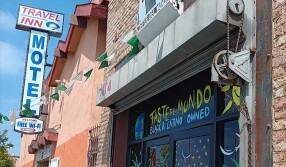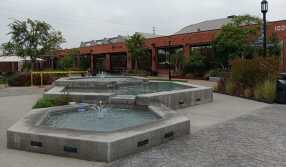These Five Great SoCal Rivers Will Help You Keep Your New Year's Resolutions

In Southern California, rivers are kind of a curiosity.
You can see them on a map. You can see the signs for them, as well as the neighboring businesses named after them.
But you can’t always recognize the rivers themselves. They might be temporarily dry and look more like just a wash – a place where the water runs when it needs someplace to go.
Or, they might’ve been dry for ages.
Several years into a drought, we’ve got plenty of dry river valleys here – but we’ve also got a few rivers with actual water running through them. And those waters can be raging in the winter season, if we get enough rainfall. (If that happens, go immediately to higher ground!)
Here are five great Southern California rivers – and the best ways to enjoy the outdoors alongside them throughout 2017.
1. The Los Angeles River (Canoga Park to Long Beach)
The L.A. River is the riparian habitat that’s been grabbing all the headlines lately, thanks to the involvement of starchitect Frank Gehry in the Los Angeles River Revitalization Project. But as few as five years ago, lots of people didn’t even know that L.A. had a river. Back in 2012, it was technically still illegal to visit this not-so-natural feature of L.A. that exists somewhere between watershed project, natural resource, real estate development, and public open space. And that means that for years, the river's locked gates were a beacon for the other disenfranchised, disadvantaged, and ne'er-do-wells of the city. Now, we’ve got an abundance of greenways alongside the L.A. River that feature multi-use paths for bicyclists, joggers, walkers, and strollers – although they’re not all connected yet. Along the river’s 51 miles, you can find a 10-mile stretch that travels through the soft-bottom portion in the Elysian Valley, known as the Glendale Narrows – though it stops and then picks up again south of DTLA to take you 18 miles all the way to Long Beach. There are increasingly more places to stop along the river, from parks, picnic areas, and gardens to historic bridges and public art. The soft-bottom portions of the upper river provide excellent birdwatching opportunities, and they’re both open for recreation (boating, fishing) for a few months in the summer. Guided kayak tours are available May to September through L.A. River Expeditions, L.A. River Kayak Safari, and Paddle the L.A. River, a program of the non-profit L.A. Conservation Corps. For a more leisurely time, book a trip heading downstream in the Sepulveda Basin area. For higher-class rapids, brave the wild and rocky ride through the Elysian Valley. Whichever route you choose, it’s an absolute bucket list item for any Angeleno.


2. Arroyo Seco (Angeles National Forest to Northeast L.A.)
With a name that means “dry stream” in Spanish, the Arroyo Seco is technically considered a “seasonal” river that extends for nearly 25 miles, passing through La Canada Flintridge, Pasadena, and Highland Park. You’re sure to find it somewhere alongside the 110 Freeway, a.k.a. the Arroyo Seco Parkway, but a good, accessible starting point that lends itself to walking and biking is at the foothills of the Angeles National Forest (near JPL), around Hahamonga Watershed Park. Head north on the Gabrielino Trail from Altadena to one of the national forest campgrounds, like Gouda Mesa. Or, head south to the Devil's Gate Dam, a huge concrete barrier built in the 1920s for flood control and water conservation, and the Rose Bowl, where there’s a 3.1-mile loop. There, you can find some remnants of the ditch (or zanja, an early predecessor to an aqueduct) that Benjamin Eaton built in 1867 to bring water from the river to the surrounding communities – particularly along the very short Zanja Street. Farther south, you can pick up the Arroyo Seco Trail at North Arroyo Boulevard just before it passes under the Ventura Freeway and explore the Lower Arroyo under the Colorado Bridge, all the way down to where South San Rafael Avenue meets South Arroyo Boulevard. The Arroyo Seco Bike Path starts near the Marmion Way exit off the Arroyo Seco Parkway, which takes you all the way down to Montecito Heights, but you’re allowed to bike on pretty much any paved stretch of the trail. Maps and trail guides are available from the City of Pasadena and the Arroyo Seco Foundation.


[view:kl_map_points==socal wanderer]
3. San Gabriel River and The Bridge to Nowhere
Although it stretches for 60 miles between the San Gabriel Mountains and Orange County, probably the most spectacular – and relatively difficult – way to enjoy the San Gabriel River (namesake of the San Gabriel Mission) is at its headwaters, climaxing at the Bridge to Nowhere along the East Fork Trail. It’s relatively shady at the beginning and eventually takes you past old foundations, bridge footings and other vestiges along the way – and it also requires you to cross the San Gabriel River, back and forth, more than once or twice. The wet river crossings can prove to be a challenge, as the water can be waist-high even in times of drought. In general, the terrain along the East Fork Trail is extremely variable. It can turn from a forested, riparian habitat to wide-open buckwheat fields in a matter of minutes… and then, of course, back to river. Enjoy the fan palms and sprouting agave plants as you teeter along sandy ridges on this hike, which can clock in at anywhere from nine to 11 miles, depending on how far from the trailhead you have to park. The payoff comes at the 1930s-era concrete bridge, whose access roads on either side were washed away in floods. The hulking bridge, however, still stands, surrounded by a veritable rockslide of granite particles. The view from atop is stunning, but you’ll find many hikers jumping off cliffs into the pools of San Gabriel river water that has collected below. Make no mistake: This hike is more difficult than it seems, especially if the water level is high enough to make rock-hopping a futile effort. If you’re forced to wade through the water, beware of twisting an ankle or otherwise losing your footing – because, as the rangers will tell you, there's only one way in and one way out of that canyon. And that’s by walking.


4. San Diego River and Mission Trails Regional Park
San Diego has a huge parcel of open space in a relatively urban environment called Mission Trails Regional Park, much of which was once used as a U.S. Marine Corps Weapons Training Center called Camp Elliott (1917 to 1960). There, soldiers in training once shot at the mountains for target practice. But while you may not find any of the shells, mortars, and other projectiles that were left scattered about there, you will find what’s left of the San Diego River. Appearing as more of a green valley at first glance, it’s no surprise that this area was used in its pre-military days for ranching and farming. Before that, the Kumeyaay people lived off the land here, using rocks to grind acorns and seeds into meal. Experienced in manipulating rivers to create pools for bathing and trapping wildlife, the Kumeyaay probably also helped the padres build the Old Mission Dam out of granite boulders and limestone mortar, creating a dependable water source for the Catholic missionaries who thought the granted land otherwise unusable. In the park, the river appropriately follows alongside Father Junipero Serra Trail. Elsewhere, it technically runs from the mountains northwest of the town of Julian all the way out to Mission Bay (by Sea World), but this is a particularly elusive river, making it hard to find. There’s a conceptual plan to connect its many disparate parts for seamless recreational opportunities – but it’s not quite there yet, so for now, Mission Trails is your best bet.


5. Santa Margarita River and Preserve
At just 30 miles in length, the Santa Margarita River is relatively small in comparison to other SoCal rivers. But its 742-square-mile watershed is actually the second largest river basin on the Southern California coastal plain. And while many of its peers have been channelized for flood control, the Santa Margarita is one of the last free-flowing rivers in the area. Named after Saint Margaret of Antioch by the Spanish explorers of the Portolà expedition in 1769, the Santa Margarita River runs south of Temecula and passes through the 220-plus acres of the Santa Margarita Preserve. Along the trails, a visible, audible, free-flowing stream suddenly appears and then disappears again behind the overgrowth. At some point, you may find yourself inside a depression in the land, with tree roots exposed by the river that once flowed. This is when you’re no longer following the path of the river – but, rather, you’re in the river. In total, there are 14 miles of river trails in the preserve, but you can make a round trip hike as short as three miles. Even the shortest spur starting from the parking area is a good workout, since the trail surface is frequently soft sand (which requires at least twice as much energy as walking on a paved surface). Be prepared to meet some mountain bikers and equestrians along the trail, and keep your eyes (and ears) open for deer as well as endangered species like the Least Bell’s Vireo. A comprehensive trail map is available from the Fallbrook Trails Council.


Pro Tip: In one hour, running 5.5 mph burns 454 calories (or an In-N-Out cheeseburger with onion), kayaking burns 283 calories (or a half-bottle of champagne), and cycling 5.5 mph burns 227 calories (or one medium California avocado) in a 125-pound person, according to the American Council on Exercise. If you’re hiking, the amount of calories you’ll burn depends on the terrain, elevation change, and how much weight you’re carrying in your pack. But even an hour-long hike at a relatively leisurely pace of a 20-minute mile can burn somewhere around 400 calories – more or less offsetting that last French dip sandwich you ate.















